一般现在时语法
完整版)一般现在时的语法总结

完整版)一般现在时的语法总结一般现在时是用来表示通常性、规律性、惯性状态或动作的时间状态。
当主语为第三人称单数时,肯定句的结构为主语+动词的第三人称单数+其他,否定句为主语+doesn't+动词原形+其他,一般疑问句为Does+主语+动词原形+其他,肯定回答为Yes,主语+does,否定回答为No,主语+doesn't。
特殊疑问句为特殊疑问词+一般疑问句。
当主语不是第三人称单数时,肯定句的结构为主语+动词原形+其他,否定句为主语+don't+动词原形+其他,一般疑问句为Do+主语+动词原形+其他,肯定回答为Yes,主语+do,否定回答为No,主语+don't。
需要注意的是,句式结构错则全局都错。
变化规律包括清辅音后读/s/,一般情况加-s,浊辅音和元音后读/z/,以o结尾的词、以s、sh、ch、x等结尾的词、以辅音字母+y结尾的词加-es读/z/,变y为i再加es,变have为has,变be为am、is、are读/z/。
一般现在时可以用来表示经常的或惯性的动作,常与表示频率的时间状语连用,如always、usually、regularly、XXX、often、sometimes、nally、from time to time、twice a week、rarely、seldom、once a month、hardly、ever、never。
也可以用来表示主语具备的性格、能力、特征和状态。
3.用一般现在时来表达客观事实和普遍真理,例如:地球绕着太阳转,上海位于中国的东部。
4.在时间状语从句和条件状语从句中,常用一般现在时代替将来时。
5.一般现在时用于表示预先计划或安排好的行为。
6.在小说故事中,一般现在时常代替一般过去时。
而在新闻报道等内容中,为了体现其“新鲜”性,也常用一般现在时来描述过去发生的事情。
7.有些表示状态和感觉的动词在描述现在发生的具体行为时,只用一般现在时,而不用进行时态。
一般现在时的结构和用法
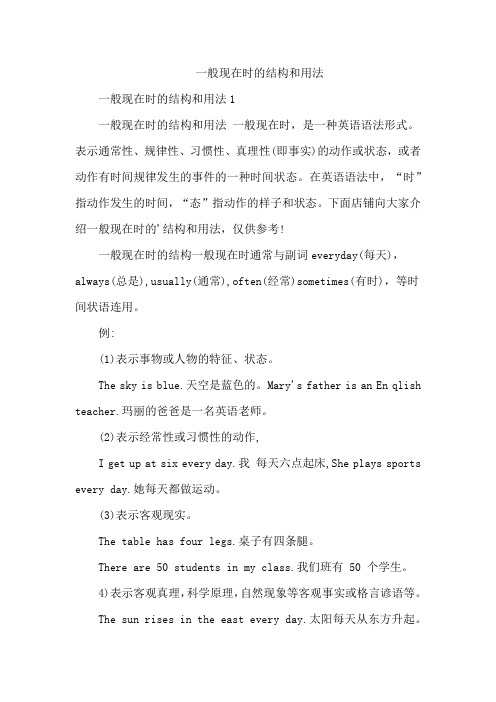
一般现在时的结构和用法一般现在时的结构和用法1一般现在时的结构和用法一般现在时,是一种英语语法形式。
表示通常性、规律性、习惯性、真理性(即事实)的动作或状态,或者动作有时间规律发生的事件的一种时间状态。
在英语语法中,“时”指动作发生的时间,“态”指动作的样子和状态。
下面店铺向大家介绍一般现在时的'结构和用法,仅供参考!一般现在时的结构一般现在时通常与副词everyday(每天),always(总是),usually(通常),often(经常)sometimes(有时),等时间状语连用。
例:(1)表示事物或人物的特征、状态。
The sky is blue.天空是蓝色的。
Mary's father is an En qlish teacher.玛丽的爸爸是一名英语老师。
(2)表示经常性或习惯性的动作,I get up at six every day.我每天六点起床,She plays sports every day.她每天都做运动。
(3)表示客观现实。
The table has four legs.桌子有四条腿。
There are 50 students in my class.我们班有 50 个学生。
4)表示客观真理,科学原理,自然现象等客观事实或格言谚语等。
The sun rises in the east every day.太阳每天从东方升起。
The earth goes around the sun.地球绕着太阳转。
(5) 表示平日的喜好。
I like bananas. We don't like vegetables.He likes ice cream.She doesn't like strawberries.一般现在时的用法经常性或习惯性的动作,常与表示频腮度的时间状语连用。
(1)时间状语:every.. sometimes, at.. on Sun dayi leave home for school at 7 every morning.(2)客观真理,客观存在,科学事实。
一般现在时的语法总结(最新整理)
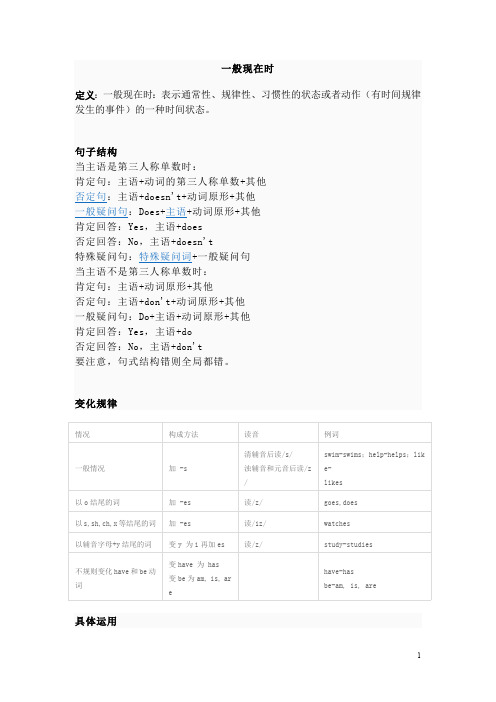
study-studies
不规则变化 have 和 be 动 词
变 have 为 has 变 be 为 am, is, ar e
have-has be-am, is, are
具体运用
1
1.表示经常的或习惯性的动作,常与表示频率的时间状语连用。
时间状语: always, usually,regularly,every morning/night/evening/day/week/year,often,sometimes,occasionally ,from time to time,twice a week,rarely,seldom,once a month, hardly, ever,never.
变化规律
情况
构成方法
读音
例词
一般情况
加 -s
清辅音后读/s/ 浊辅音和元音后读/z /
swim-swims;help-helps;lik elikes
以 o 结尾的词
加 -es
Байду номын сангаас读/z/
goes,does
以 s,sh,ch,x 等结尾的词 加 -es
读/iz/
watches
以辅音字母+y 结尾的词 变 y 为 i 再加 es 读/z/
编辑本段表示过去
1.用于某些动词(tell, say, hear, learn, gather 等)表示不确定的过 去时间: John tells me you will leave tomorrow. 约翰告诉我你明天离开。 I hear that he got married again last month. 我听说他上个月结婚 了。 Mary says that you told her to come over here. 玛丽说是你让她到这 儿来的。
英语语法一般现在时,结构,用法全打尽!(附习题)
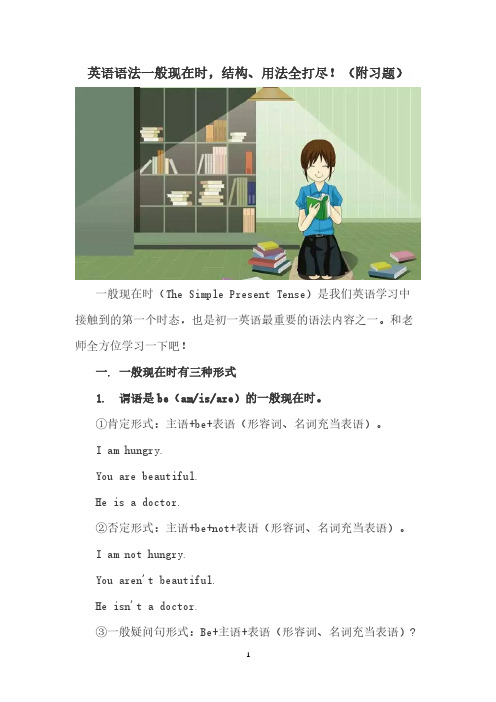
英语语法一般现在时,结构、用法全打尽!(附习题)一般现在时(The Simple Present Tense)是我们英语学习中接触到的第一个时态,也是初一英语最重要的语法内容之一。
和老师全方位学习一下吧!一. 一般现在时有三种形式1. 谓语是be(am/is/are)的一般现在时。
①肯定形式:主语+be+表语(形容词、名词充当表语)。
I am hungry.You are beautiful.He is a doctor.②否定形式:主语+be+not+表语(形容词、名词充当表语)。
I am not hungry.You aren't beautiful.He isn't a doctor.③一般疑问句形式:Be+主语+表语(形容词、名词充当表语)?肯定回答:Yes,主语+be. 否定回答:No, 主语+ be+not.—Are you hungry?—Yes,I am./No,I'm not.—Is he a doctor?—Yes, he is./No, he isn,t.④特殊疑问句形式:特殊疑问词+Be开头的一般疑问句?—What is he?—He is a doctor.注意:be要随着主语变。
2. 谓语动词是实义动词(及物动词或不及物动词)的一般现在时。
①肯定形式:“主语+及物动词+宾语”或“主语+不及物动词”。
She has a little brother.她有一个弟弟。
The sun rises in the east.太阳从东方升起。
②否定形式:“主语+don't/doesn't+及物动词+宾语”或“主语+don't/doesn't+不及物动词”。
She doesn't have a little brother.她没有弟弟。
I don't eat every morning.我每天早晨都不吃饭。
③一般疑问句形式:“Do/Does+主语+及物动词原形+宾语”或“Do/Does+主语+不及物动词原形”。
语法--一般现在时
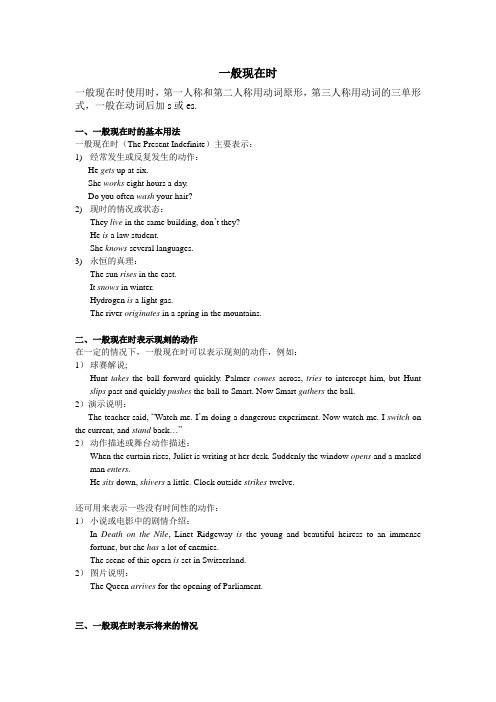
一般现在时一般现在时使用时,第一人称和第二人称用动词原形,第三人称用动词的三单形式,一般在动词后加s或es.一、一般现在时的基本用法一般现在时(The Present Indefinite)主要表示:1)经常发生或反复发生的动作:He gets up at six.She works eight hours a day.Do you often wash your hair?2)现时的情况或状态:They live in the same building, don’t they?He is a law student.She knows several languages.3)永恒的真理:The sun rises in the east.It snows in winter.Hydrogen is a light gas.The river originates in a spring in the mountains.二、一般现在时表示现刻的动作在一定的情况下,一般现在时可以表示现刻的动作,例如:1)球赛解说;Hunt takes the ball forward quickly. Palmer comes across, tries to intercept him, but Hunt slips past and quickly pushes the ball to Smart. Now Smart gathers the ball.2)演示说明:The teacher said, “Watch me. I’m doing a dangerous experiment. Now watch me. I switch on the current, and stand back…”2)动作描述或舞台动作描述:When the curtain rises, Juliet is writing at her desk. Suddenly the window opens and a masked man enters.He sits down, shivers a little. Clock outside strikes twelve.还可用来表示一些没有时间性的动作:1)小说或电影中的剧情介绍:In Death on the Nile, Linet Ridgeway is the young and beautiful heiress to an immense fortune, but she has a lot of enemies.The scene of this opera is set in Switzerland.2)图片说明:The Queen arrives for the opening of Parliament.三、一般现在时表示将来的情况1)在口语中,一般现在时可以表示按规定、计划或时间表要发生的事,通常都有一个表示未来时间的状语:The plane takes off at 9:20 a.m.Their delegation arrives here tomorrow afternoon.I’m in my office from two to five this afternoon.The train leaves in five minutes’ time.有时可用这个时态叙述整个计划:We leave London at 10:00 next Tuesday and arrive in Paris at 13:00. We spend two hours in Paris and leave again at 15:00. We arrive in Rome at 19:30, spend four hours in Rome.2)在时间或条件从句中,须用一般现在时表示将来动作:If I see Nancy I’ll ask her.I’ll discuss this with you when we meet.We’ll let you know as soon as you arrive.In case I forget, please remind me about it.I won’t write unless he writes first.一般现在时练习题精选1.The soup ______ good.A. tasteB. tastedC. tastesD. is tasted2. Metal _______ when heated.A. expandsB. is expandedC. expandD. expanded3. Shakespeare________, “Neither a borrower nor a lender be.”A. saidB. sayC. saysD. had said4. A notice at the end of the road___________ people not to go any further.A. warnedB. warnC. warnsD. is warning5. The plane ___________ at 9:20 a.m.A. takes offB. take offC. took offD. will take off6. I’ll tell her after you _________.A. leavesB. leftC. leaveD. will leave(2011年全国卷1)23. Planning so far ahead ___________ no sense-so many things will have changed by next year.A. madeB. is makingC. makesD. has made。
一般现在时语法总结

一般现在时描述了我们日常生活中经常发生或普遍存在的事情。了解一般现 在时的基础结构、用法和常见动词变化规则。
一般现在时的定义
什么是一般现在时
一般现在时表示现在经常发生或普遍存在的事情。
一般现在时的基本结构和用法
一般现在时的基本结构是主语+动词原形(规则动词加-s/-es)。它用于描述客观事实、经常 性行为、普遍真理和现阶段的状态。
every day, every week, on Mondays
练习和注意事项
1
练习一般现在时的
通过练习巩固你对一般现在时的理解和 运用。
3 表示现阶段的状态
一般现在时还可以用来描述现阶段的状态或 存在。
4 表示客观存在的事实
当我们描述客观存在的事实时,常使用一般 现在时。
常用时间状语副词
表示现在的时间
now, currently, at present
表示经常性的时间
always, usually, frequently
表示固定的时间
规则动词和不规则动词的变化
ቤተ መጻሕፍቲ ባይዱ规则动词的变化规则
大多数动词在一般现在时下只需在第三人称单数形 式后加上-s/-es。
不规则动词的变化形式
部分动词在一般现在时下有不规则的变化形式。
一般现在时的常见用法
1 表示经常性的行为
一般现在时经常用于描述我们日常生活中重 复发生的行为。
2 表示普遍真理
我们可以使用一般现在时来说明普遍真理或 普遍适用的事实。
一般现在时语法格式
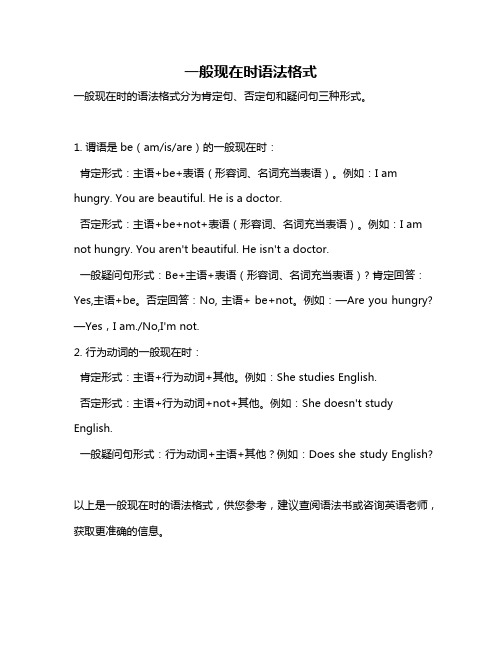
一般现在时语法格式
一般现在时的语法格式分为肯定句、否定句和疑问句三种形式。
1. 谓语是be(am/is/are)的一般现在时:
肯定形式:主语+be+表语(形容词、名词充当表语)。
例如:I am hungry. You are beautiful. He is a doctor.
否定形式:主语+be+not+表语(形容词、名词充当表语)。
例如:I am not hungry. You aren't beautiful. He isn't a doctor.
一般疑问句形式:Be+主语+表语(形容词、名词充当表语)? 肯定回答:Yes,主语+be。
否定回答:No, 主语+ be+not。
例如:—Are you hungry? —Yes,I am./No,I'm not.
2. 行为动词的一般现在时:
肯定形式:主语+行为动词+其他。
例如:She studies English.
否定形式:主语+行为动词+not+其他。
例如:She doesn't study English.
一般疑问句形式:行为动词+主语+其他?例如:Does she study English?
以上是一般现在时的语法格式,供您参考,建议查阅语法书或咨询英语老师,获取更准确的信息。
一般现在时语法知识点总结

一般现在时语法知识点总结一、一般现在时的概念。
一般现在时表示经常的、习惯性的动作或存在的状态。
例如:I often get up at six o'clock.(我经常在六点钟起床。
)The earth goes around the sun.(地球绕着太阳转。
)二、一般现在时的构成。
1. be动词的一般现在时形式。
- 主语为第一人称单数(I)时,be动词用am。
例如:I am a student.- 主语为第三人称单数(he/she/it等)时,be动词用is。
例如:He is a doctor.- 主语为第二人称单数(you)、第一人称复数(we)、第二人称复数(you)、第三人称复数(they)时,be动词用are。
例如:You are my friends. They are workers.2. 实义动词(行为动词)的一般现在时形式。
- 当主语为第三人称单数(he/she/it,单个的人名、地名或单数可数名词等)时,实义动词一般在词尾加 -s或 -es。
- 一般情况下加 -s,如:play - plays,like - likes。
- 以s,x,ch,sh,o结尾的动词加 -es,如:go - goes,watch - watches。
- 以辅音字母 + y结尾的动词,把y变为i再加 -es,如:study - studies。
- 当主语为第一人称单数(I)、第二人称单数(you)、第一人称复数(we)、第二人称复数(you)、第三人称复数(they)时,实义动词用原形。
例如:I like reading. They play football every day.三、一般现在时的用法。
1. 表示经常或习惯性的动作。
- 常与表示频率的副词或短语连用,如:always(总是),usually(通常),often(经常),sometimes(有时),seldom(很少),never(从不),every day (每天),once a week(每周一次)等。
一般现在时(语法+习题)
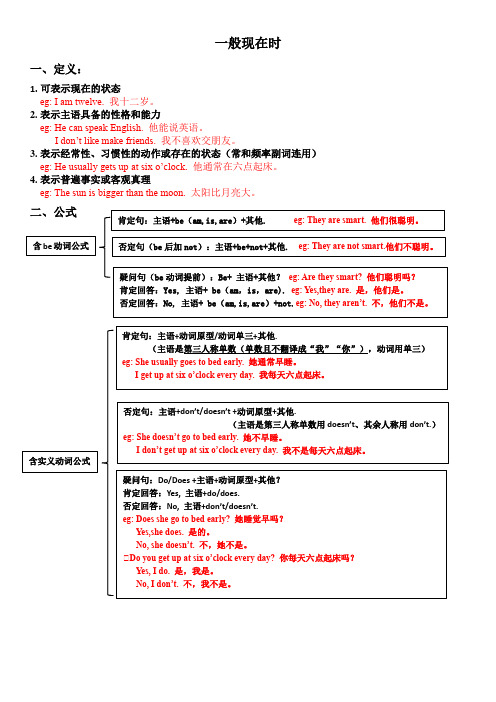
一般现在时一、定义:1.可表示现在的状态eg: I am twelve. 我十二岁。
2.表示主语具备的性格和能力eg: He can speak English. 他能说英语。
I don’t like make friends. 我不喜欢交朋友。
3.表示经常性、习惯性的动作或存在的状态(常和频率副词连用)eg: He usually gets up at six o’clock. 他通常在六点起床。
4.表示普遍事实或客观真理eg: The sun is bigger than the moon. 太阳比月亮大。
二、公式三、动词变第三人称单数的规则1.直接加s(读音:清辅音后读[s],元音和浊辅音后读[z])eg: help-helps come-comes2.以s,x,sh,ch,o结尾,加es(读音:es读[ɪz],goes和does除外)eg: watch-watches wash-washes do-does miss-misses3.以辅音加y结尾,把y变i加es(读音:es读[z])eg: try-tries study-studies4.特殊:have-has四、练习巩固:写出下列动词的单三形式go__________ catch_________ brush(刷)_____ teach_______do________ like________ have___________ watch________ drink ___________ fly___________ say_______ learn ___________ eat___________ read___________ sing___________ buy__________ study_______ stay __________ make __________ look ______ pass__________ carry ____ come__________ plant(种植)______用单词正确形式填空。
英语常见时态语法结构
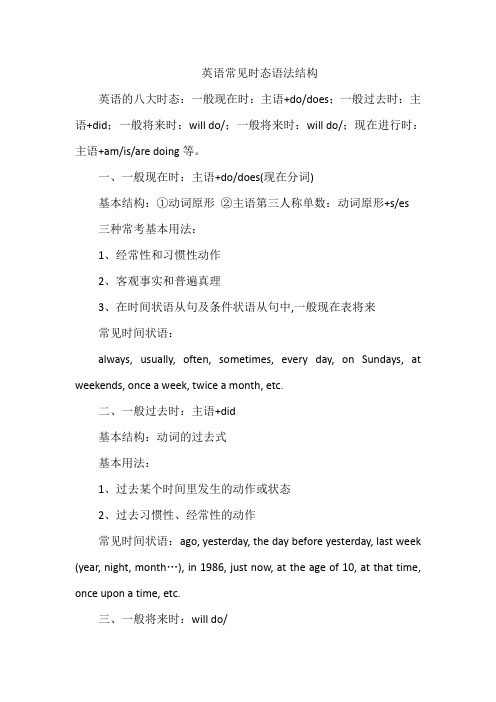
英语常见时态语法结构英语的八大时态:一般现在时:主语+do/does;一般过去时:主语+did;一般将来时:will do/;一般将来时:will do/;现在进行时:主语+am/is/are doing等。
一、一般现在时:主语+do/does(现在分词)基本结构:①动词原形②主语第三人称单数:动词原形+s/es三种常考基本用法:1、经常性和习惯性动作2、客观事实和普遍真理3、在时间状语从句及条件状语从句中,一般现在表将来常见时间状语:always, usually, often, sometimes, every day, on Sundays, at weekends, once a week, twice a month, etc.二、一般过去时:主语+did基本结构:动词的过去式基本用法:1、过去某个时间里发生的动作或状态2、过去习惯性、经常性的动作常见时间状语:ago, yesterday, the day before yesterday, last week (year, night, month…), in 1986, just now, at the age of 10, at that time, once upon a time, etc.三、一般将来时:will do/基本结构:①am/is/are/going to + do;②will/shall + do.基本用法:1、(人)计划打算做某事2、(事)即将发生will/shall do1、将来的动作和状态(相对较长远)2、礼貌询问、客气邀请3、意愿常见时间状语:tomorrow, next day (week, month, year…), soon, the day after tomorrow, in+时间段(格外注意),etc.四、现在进行时:主语+am/is/are doing基本结构:am/is/are+现在分词基本用法:1、此时此刻正在进行的动作2、现阶段正在进行的动作常见时间状语:now, at this time, these days, etc.五、过去进行时:was/were doing基本结构:was/were+现在分词基本用法:1、过去某时刻正在进行的动作2、过去某时段正在进行的动作常见时间状语:at this time yesterday, at that time或以when引导的谓语动词是一般过去时的时间状语等.六、过去将来时:was/were to /would do基本结构:①was/were/going to + do;②would/should + do.基本用法:从过去时间点看将来,常用于宾语从句中.常见时间状语:the next day (morning, year…), the following month (week…), etc.七、现在完成时:have/has done基本结构:have/has + 过去分词基本用法:1、过去发生的动作对现在造成的影响或结果2、过去已经开始,持续到现在的动作或状态常见时间状语:recently, lately, so far, up to now, since+时间点,for+时间段, in the past few years, etc.八、过去完成时:had done基本结构:had + 过去分词基本用法:以过去某个时间为标准,在此以前发生的动作或行为,即"过去的过去".常见时间状语:before, after, by the end of last year(month…),etc.。
一般现在时语法点

一般现在时:日常对话的“万能钥匙”嘿,朋友们,今天咱们来聊聊英语里的一个超级实用的语法点——一般现在时。
别听这名字高大上,其实它就像是你我日常对话中的“万能钥匙”,开门见山,直截了当。
首先,你得明白啥是一般现在时。
简单说,就是现在经常发生的动作,或者是一直保持的状态,还有科学真理、客观事实,统统都能用一般现在时来表达。
就像咱们每天吃饭、睡觉、上班,还有太阳从东边升起,这些都是一般现在时的“菜”。
那怎么用呢?别急,我教你几招。
第一招:动词原形走天下。
没错,一般现在时里,动词基本上都是用原形。
当然啦,如果主语是第三人称单数(比如he, she, it,或者是人名、地名等单数名词),那动词后面就得加个“s”或者“es”来变形,这叫第三人称单数形式。
比如,“I eat an apple every day.”(我每天吃一个苹果。
)和“He eats an apple every day.”(他每天吃一个苹果。
)看到没,区别就在于动词的变形。
第二招:时间状语别忘加。
虽然一般现在时不怎么强调时间,但有时候加上时间状语,句子就更完整、更清晰了。
比如,“We always go for a walk after dinner.”(我们总是在晚饭后散步。
)这里的“always”就是时间状语,告诉我们这个动作是经常发生的。
第三招:客观事实不用怕。
前面说了,科学真理、客观事实也是一般现在时的地盘。
这时候,你就大胆地用动词原形,不用管主语是不是第三人称单数。
比如,“The sun rises in the east.”(太阳从东方升起。
)这就是个客观事实,所以用了动词原形“rises”,但实际上在英语里,为了保持一致性和简洁性,很多时候这种句子会直接用“rises”的简写形式“rises”,不过你得知道背后的原因哦。
好了,说了这么多,是不是觉得一般现在时其实也没那么难?没错,它就像是你我日常生活中的一部分,自然而然地就会用到了。
一般现在时的结构和用法
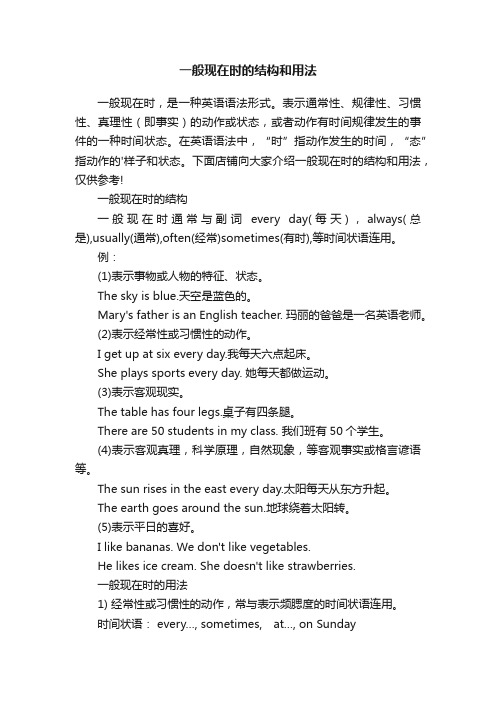
一般现在时的结构和用法一般现在时,是一种英语语法形式。
表示通常性、规律性、习惯性、真理性(即事实)的动作或状态,或者动作有时间规律发生的事件的一种时间状态。
在英语语法中,“时”指动作发生的时间,“态”指动作的'样子和状态。
下面店铺向大家介绍一般现在时的结构和用法,仅供参考!一般现在时的结构一般现在时通常与副词every day(每天),always(总是),usually(通常),often(经常)sometimes(有时),等时间状语连用。
例:(1)表示事物或人物的特征、状态。
The sky is blue.天空是蓝色的。
Mary's father is an English teacher. 玛丽的爸爸是一名英语老师。
(2)表示经常性或习惯性的动作。
I get up at six every day.我每天六点起床。
She plays sports every day. 她每天都做运动。
(3)表示客观现实。
The table has four legs.桌子有四条腿。
There are 50 students in my class. 我们班有50个学生。
(4)表示客观真理,科学原理,自然现象,等客观事实或格言谚语等。
The sun rises in the east every day.太阳每天从东方升起。
The earth goes around the sun.地球绕着太阳转。
(5)表示平日的喜好。
I like bananas. We don't like vegetables.He likes ice cream. She doesn't like strawberries.一般现在时的用法1) 经常性或习惯性的动作,常与表示频腮度的时间状语连用。
时间状语:every…, sometimes,at…, on SundayI leave home for school at 7 every morning.2) 客观真理,客观存在,科学事实。
(完整版)一般现在时的语法总结
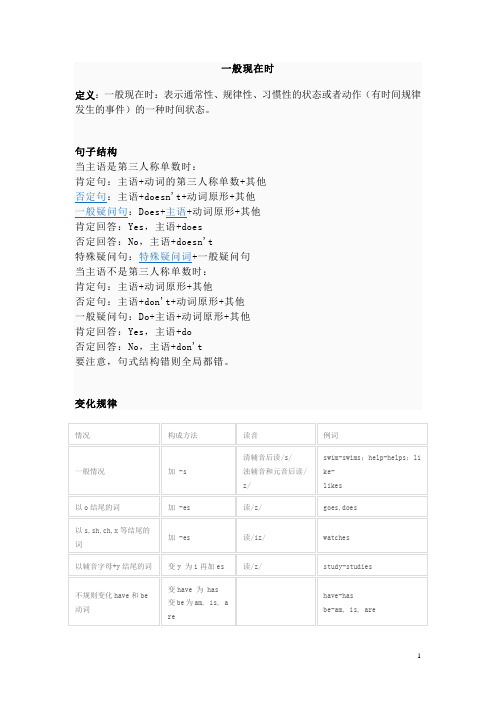
一般现在时定义:一般现在时:表示通常性、规律性、习惯性的状态或者动作(有时间规律发生的事件)的一种时间状态。
句子结构当主语是第三人称单数时:肯定句:主语+动词的第三人称单数+其他否定句:主语+doesn't+动词原形+其他一般疑问句:Does+主语+动词原形+其他肯定回答:Yes,主语+does否定回答:No,主语+doesn't特殊疑问句:特殊疑问词+一般疑问句当主语不是第三人称单数时:肯定句:主语+动词原形+其他否定句:主语+don't+动词原形+其他一般疑问句:Do+主语+动词原形+其他肯定回答:Yes,主语+do否定回答:No,主语+don't要注意,句式结构错则全局都错。
变化规律具体运用1.表示经常的或习惯性的动作,常与表示频率的时间状语连用。
时间状语: always, usually,regularly,everymorning/night/evening/day/week/year,often,sometimes,occasionally ,from time to time,twice a week,rarely,seldom,once a month, hardly, ever,never.e.g. I leave home for school at 7:00 every morning.2.表示主语具备的性格、能力、特征和状态。
e.g. I don't want so much.Ann Wang writes good English but does not speak well.比较:Now I put the sugar in the cup.I am doing my homework now.3.表示客观事实和普遍真理。
e.g The earth moves around the sun.Shanghai lies in the east of China.4.在时间状语从句和条件状语从句中,常用一般现在时代替将来时。
英语语法:一般现在时

1、一般现在时的形式
是以动词的原形表示的,当主语为第三人称单数时,做谓语的动词原形后要加上词尾s或es。
2、一般现在时的功用
⑴.表示一直发生的事情,经常发生的动作:
It often rains in summer in Beijing.
⑵.表示客观事实或者真理:
Birds fly.
⑶.谈论时间表、旅程表等,如:
三、一般现在时和现在进行时的比较
1、一话前后正在发生的动作或事情,如:
What do you do?你是干什么工作的?
What are you doing here?你在这里干什么?
2、一般现在时是表示经久的情况,而现在进行时表示的是暂时的,如:
2、现在进行时的功用
⑴、表示说话时正在发生或者进行的动作
Let’s get out. It isn’t raining any more.
⑵、表示在现在相对较长一段时间内正在进行的动作,但是说话一刻不一定在做的动作
David is teaching English and learning Chinese in Beijing.
My parents live in Shanghai. They have been there for 50 years.
She’s living with some friends until she can find an apartment.
What time does the film begin?
⑷.谈论籍贯、国籍等,如:
Where do you come from?
⑸.询问或者引用书籍、通知或新近接到的信笺内容,如:
What does Ann say in her letter?
一般现在时的语法公式
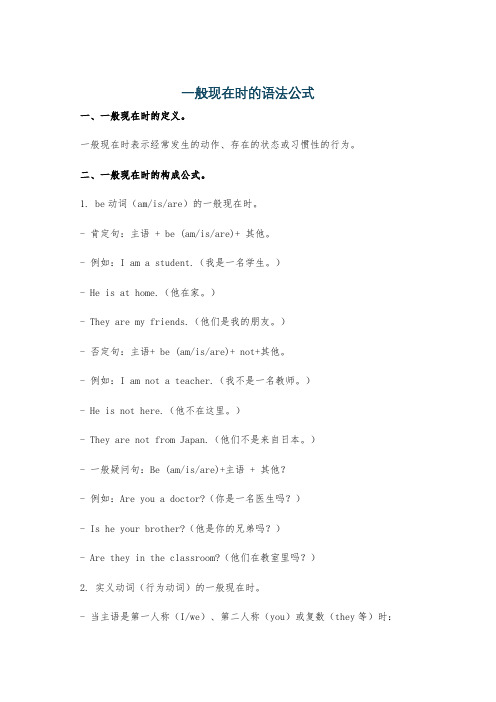
一般现在时的语法公式一、一般现在时的定义。
一般现在时表示经常发生的动作、存在的状态或习惯性的行为。
二、一般现在时的构成公式。
1. be动词(am/is/are)的一般现在时。
- 肯定句:主语 + be (am/is/are)+ 其他。
- 例如:I am a student.(我是一名学生。
)- He is at home.(他在家。
)- They are my friends.(他们是我的朋友。
)- 否定句:主语+ be (am/is/are)+ not+其他。
- 例如:I am not a teacher.(我不是一名教师。
)- He is not here.(他不在这里。
)- They are not from Japan.(他们不是来自日本。
)- 一般疑问句:Be (am/is/are)+主语 + 其他?- 例如:Are you a doctor?(你是一名医生吗?)- Is he your brother?(他是你的兄弟吗?)- Are they in the classroom?(他们在教室里吗?)2. 实义动词(行为动词)的一般现在时。
- 当主语是第一人称(I/we)、第二人称(you)或复数(they等)时:- 肯定句:主语+动词原形+其他。
- 例如:I like reading books.(我喜欢读书。
)- We play football on Sundays.(我们在星期天踢足球。
)- You go to school by bike.(你骑自行车去上学。
)- They have a lot of fun.(他们玩得很开心。
)- 否定句:主语+ don't+动词原形+其他。
- 例如:I don't like math.(我不喜欢数学。
)- We don't watch TV every day.(我们不是每天都看电视。
)- You don't know him.(你不认识他。
一般现在时的结构用法
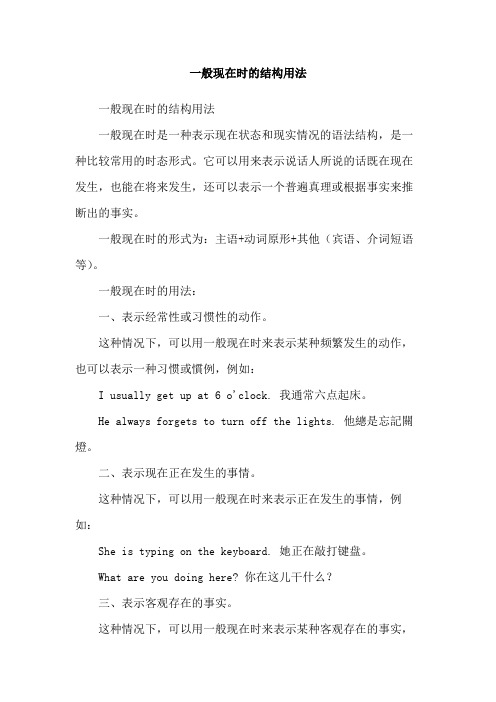
一般现在时的结构用法
一般现在时的结构用法
一般现在时是一种表示现在状态和现实情况的语法结构,是一种比较常用的时态形式。
它可以用来表示说话人所说的话既在现在发生,也能在将来发生,还可以表示一个普遍真理或根据事实来推断出的事实。
一般现在时的形式为:主语+动词原形+其他(宾语、介词短语等)。
一般现在时的用法:
一、表示经常性或习惯性的动作。
这种情况下,可以用一般现在时来表示某种频繁发生的动作,也可以表示一种习惯或慣例,例如:
I usually get up at 6 o'clock. 我通常六点起床。
He always forgets to turn off the lights. 他總是忘記關燈。
二、表示现在正在发生的事情。
这种情况下,可以用一般现在时来表示正在发生的事情,例如:
She is typing on the keyboard. 她正在敲打键盘。
What are you doing here? 你在这儿干什么?
三、表示客观存在的事实。
这种情况下,可以用一般现在时来表示某种客观存在的事实,
例如:
The earth revolves around the sun.地球围绕太阳转动。
Earthquakes occur every year.地震每年都会发生。
四、表示普遍真理或根据事实推断出的事实。
这种情况下,可以用一般现在时来表示某种普遍真理或根据事实推断出的事实,例如:
Money can't buy happiness. 金钱不能买到幸福。
He must be tired. 他一定很累。
一般现在时英语语法大全

一般现在时英语语法大全如:I am a student.(1)主语(非第三人称单数)+动词原形+其他。
如:We often watch TV at the weekends.(2)主语(第三人称单数)+动词第三人称单数形式+其他。
如:Jim usually goes to the park on Sundays.They watch TV at six every day.They don’t watch TV at six every day.Do they watch TV at six every day?Yes, they do. / No, they don’t.She watches TV at six every day.She doesn’t watch TV at six every day.Does she watch TV at six every day?Yes, she does. / No, she doesn’t.时间状语:every…, sometimes, at…, on SundayI leave home for school at 7 every morning.The earth moves around the sun.Shanghai lies in the east of China.Pride goes before a fall. 骄者必败。
注意:此用法如果出现在宾语从句中,即使主句是过去时,从句谓语也要用一般现在时。
例:Columbus proved that the earth is round..I don't want so much.Ann Wang writes good English but does not speak well.1. Now I put the sugar in the cup.2. I am doing my homework now.第一句用一般现在时,用于操作演示或指导说明的示范性动作,表示言行的瞬间动作。
- 1、下载文档前请自行甄别文档内容的完整性,平台不提供额外的编辑、内容补充、找答案等附加服务。
- 2、"仅部分预览"的文档,不可在线预览部分如存在完整性等问题,可反馈申请退款(可完整预览的文档不适用该条件!)。
- 3、如文档侵犯您的权益,请联系客服反馈,我们会尽快为您处理(人工客服工作时间:9:00-18:30)。
一般现在时
一、一般现在时的定义:
表示现在经常性、习惯性、规律性的动作或者现在存在的状态的一种时态。
二、一般现在时的用法
当一般现在时表示现在经常性、习惯性的动作时常连用的时间状语:
1)表示频度的副词:always, often, usually, sometimes
2)on Sundays, on Monday afternoons, every day/week/month/year等时间状语3)once a year, twice a month, three times a week 等表示频度的词组
三、一般现在时的构成
1) 谓语动词为be (am ,is ,are) (主语+be+其他)
I am a teacher. You are a student. He/She is a doctor.
2)谓语动词为实义动词(主语+do/does+其他)
I like English. (Chinese,Math,Science,History,Geography,Physics,Chemistry,Sociology) Mike likes English. (Chinese,Math,Science,History,Geography,Physics,Chemistry,Sociology) Mike speaks good English.
I go to school on foot (by school bus,by bus,by bike).
Lily goes to school on foot (by school bus,by bus,by bike).
Tony often watches TV in the evening.
Jack always washes in cold water.
Mike studies English,Chinese,Math at school.
Sona has musical talent.
四、动词第三人称单数变化规则
▲第三人称单数:he/she/it; 可数名词单数;不可数名词.
(口诀:不是你不是我,并且只有一个)
五、句型转换
1、谓语动词为be动词
否定:主语+be+not+其他
一般疑问句:be+主语+其他(即将be提到句首)
2、谓语动词为实义动词
肯定:主语+do/does+其他
否定:主语+助动词do/does+not+动词原形+其他
疑问:Do/Does+主语+其他
回答:肯定:Y es,主语+do/does. 否定:No,主语+do/does+not.
注意:don’t 和doesn’t 之后动词一定要用原形。
课堂练习:
一.句型转换:
1. Lucy likes going skating with her friends.
否定句:_______________________________________________________ Lucy does n’t like going skating with her fri ends.
一般疑问句:___________________________________________________ Does Lucy like going skating with her friends ?
2. His watch costs 300 yuan. (变成一般疑问句并否定回答)
_______________________________________________________________ Does his watch cost 300 yuan ?
No,it doesn’t.
二、用所给动词的适当形式填空。
1. We often_________(play) football in the playground.
2. He _______(get) up at six o’clock.
3. ________you ________(brush) your teeth every morning.
4. What (do) he usually (do) after school?
5. Danny _________ (study) English, Chinese, Maths, Science and Art at school.
6. Mike sometimes _________(go) to the park with his sister.
7. Tom ________ ( study ) English, Chinese, Maths, Science and Art at school.
8. _______ Mike________(read) English every day?
9. How many lessons _______your classmate_______(have) on Monday?
10. What time ________his mother________(do) the housework?
11. Mike _________(like) cooking.
12. They ______(have) the same hobby.
13. My aunt _______(look) after her baby carefully.
14. You always__________ (do) your homework well.
15. I __________(be) ill. I’m staying in bed.
16. She __________ (go) to school from Monday to Friday.
17. Liu Tao __________ (do) not like PE.
18. The child often __________ (watch) TV in the evening.
19. Su Hai and Su Yang __________ (have) eight lessons this term.
20. What day __________ (be) it today? - It’s Saturday.
21. He often _______(have) dinner at home.
22. Daniel and Tommy _______(be) in Class One.
23. We _________(not watch) TV on Monday.
24. Nick _________(not go) to the zoo on Sunday.
25. They (like) the World Cup.
26. What they often (do) on Saturdays?
27. My parents (read) newspapers every day.
28. The girl (teach) us English on Sundays.
29. She and I (take) a walk together every evening.
30. There (be) some water in the bottle.
31. What time_________ his father_________(do) the work?
32.I _______(get) up at six o’clock.
33._________ you _________(brush) your teeth every morning.
34. What ________ ( do ) he usually ________( do ) after school?
35.How many lessons _______your classmates_______(have) on Monday?
习题答案:
1.play
2.gets
3.Do; brush
4.does do
5. studies
6. goes
7.studies
8.Does ;read
9.does ;have 10.does ;do
11.likes 12.have 13.looks 14.do 15.am 16.goes 17.does 18.watches 19.have 20.is 21.has 22.are 23.don’t watch 24.doesn’t go 25.like 26.do 27.read 28.teaches 29.take 30.is 31.does do 32.get 33.Do; brush 34.does;do 35.do; have。
